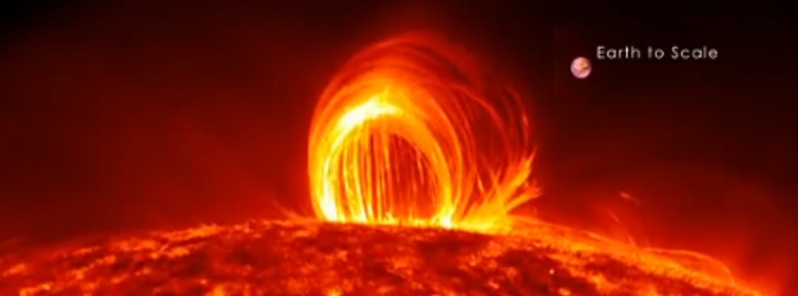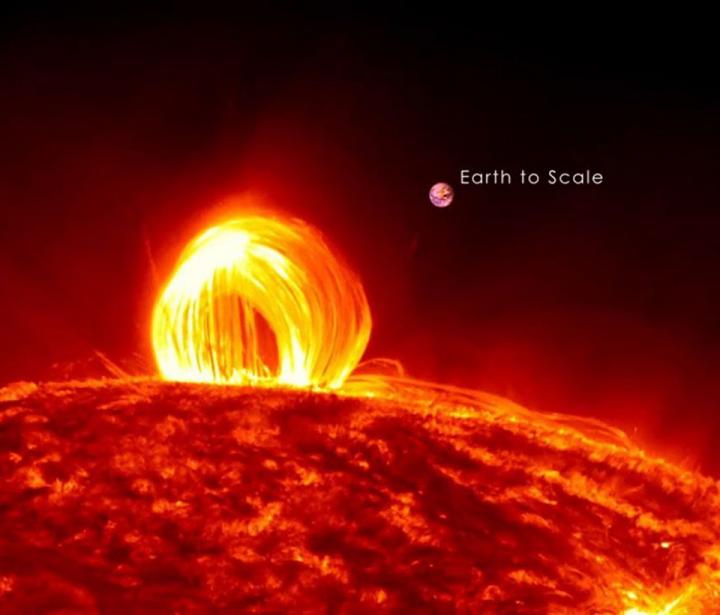Researchers propose new formation mechanism for solar coronal rain

Coronal rain is a phenomenon on the Sun that plays a key role in the mass cycle between the hot corona and cool chromosphere. In a new study, a team of researchers has proposed a new formation mechanism for coronal rain along open magnetic structures, showing that the higher-lying open structures reconnect with the lower-lying closed loops, forming a magnetic dip in the former.
Coronal rain usually occurs in post-flare loops and the non-flaring active region loops. It is classified into two categories– flare-driven and quiescent coronal rain, depending on its relation to the flare. Both form along structures that are magnetically closed.
In a new study, researchers proposed a new formation mechanism for coronal rain. In this mechanism, the higher-lying open structures link with the lower-lying closed loops, forming a magnetic dip in the former.
The plasma converges into the dip, resulting in the enhancement of plasma density, which triggers thermal instability. Thus, cooling and condensation of hot coronal plasma in the dip occurs. The cool condensation alls toward the solar surface as coronal rain.
In this new type of coronal rain, no flare was detected during the reconnection and condensation process. Thus, it belongs to the category of quiescent coronal rain.
"The quiescent coronal rain forming along the open structures is quite different from the flare-driven coronal rain in post-flare loops and the quiescent coronal rain in non-flaring active region loops that occur in the closed loops," said first author, Dr. Li Leping.
"Whether the condensation facilitated by reconnection can still be observed on the disk, and how it performs, are open questions," co-author Hardi Peter added, a professor from the Max Planck Institute for Solar System Research.

Image: Flare-driven coronal rain. Credit: NASA/SDO/Goddard Scientific Visualization Studio
The team found that the reconnection events from September 2010 to September 2011 observed above the limb of the Solar Terrestrial Relations Observatory took place on the disk of the Solar Dynamics Observatory.
"The event presented is important for understanding the global picture of condensation formation in the solar atmosphere and the combined observations bring a very interesting means to analyze this type of coronal condensation events," the reviewer of the paper wrote.
Li added, "If only the on-disk observations are available, the relation between the condensations and reconnection, shown clearly by the off-limb observations, could not be identified. We propose that some on-disk condensation events seen in the transition region and chromospheric lines could be facilitated by interchange reconnection."
Reference
"On-disk Solar Coronal Condensations Facilitated by Magnetic Reconnection between Open and Closed Magnetic Structures" – Li, L., et al. – The Astrophysical Journal – http://dx.doi.org/10.3847/1538-4357/abe537
Abstract
Coronal condensation and rain are a crucial part of the mass cycle between the corona and chromosphere. In some cases, condensation and subsequent rain originate in the magnetic dips formed during magnetic reconnection. This provides a new and alternative formation mechanism for coronal rain. Until now, only off-limb, rather than on-disk, condensation events during reconnection have been reported. In this paper, employing extreme-ultraviolet (EUV) images of the Solar Terrestrial Relations Observatory (STEREO) and Solar Dynamics Observatory (SDO), we investigate the condensations facilitated by reconnection from 2011 July 14–15, when STEREO was in quadrature with respect to the Sun–Earth line. Above the limb, in STEREO/EUV Imager (EUVI) 171 Å images, higher-lying open structures move downward, reconnect with the lower-lying closed loops, and form dips. Two sets of newly reconnected structures then form. In the dips, bright condensations occur in the EUVI 304 Å images repeatedly, which then flow downward to the surface. In the on-disk observations by SDO/Atmospheric Imaging Assembly (AIA) in the 171 Å channel, these magnetic structures are difficult to identify. Dark condensations appear in the AIA 304 Å images, and then move to the surface as on-disk coronal rain. The cooling and condensation of coronal plasma is revealed by the EUV light curves. If only the on-disk observations were be available, the relation between the condensations and reconnection, shown clearly by the off-limb observations, could not be identified. Thus, we suggest that some on-disk condensation events seen in transition region and chromospheric lines may be facilitated by reconnection.
Featured image credit: NASA/SDO/Goddard Scientific Visualization Studio

Magnetic Reconnection is Pseudoscience Notion…………………….Although, the concept of magnetic reconnection is widely used and only superficially in explaining many astrophysical phenomena, in physical reality, it is one of the biggest pseudo physics notions. The elegant theory of magnetic reconnection does not explain those energetic events, that take place in the Sun or anywhere else in the Universe. The equations of magnetic reconnection assume very slow discharge of energy lasting for years, but as it can be observed, solar flares discharge in minutes with far more energy than what theoretical models assume. Conventional astrophysicists cannot and will not be able to solve this puzzle of excess energy production within the framework of the theory of “magnetic reconnection”. Moreover, whenever this phenomenon takes place, there are regions of electron-depleted space associated with it. And a two-layer flow of particles is formed that speeds those electron depleted atoms. Read the rest from my published paper THE EXTERNAL ENERGY SUPPLY TO THE SUN IS OVERWHELMINGLY OBVIOUS AND HAS RECENTLY BEEN DETECTED BY SPACE PROBES. https://www.journalcra.com/sites/default/files/issue-pdf/23817_0.pdf